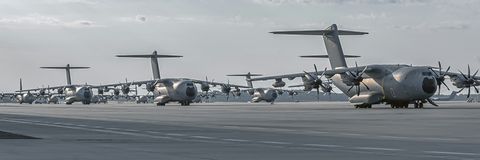Arctic Defender 24: Eurofighter symbiosis with a view

In their office, René and Sebastian probably had the best view in all of Eielson Air Force Base. So when the air exercise Arctic Defender started, only a window pane and 200 metres separated them from the action unfolding right in front of them: American, German, French and Spanish fighter jets taking off one after the other, soaring into the Alaskan skies. At times, up to 60 military aircraft were in the air simultaneously, practising for the worst case: an attack on NATO territory.

Arctic Defender, which took place from 8 to 18 July 2024 in Fairbanks, Alaska, was the first leg of one of the largest air exercises to date. Pacific Skies aims at strengthening the operational capability of NATO allies and proving that they can enforce the principles of a rule-based international order in a conflict. 8 German Eurofighters of Tactical Air Wing 31 “Boelcke” were part of the action in Alaska which was led by the German Air Force. And this is where René and Sebastian came into play.
Enabling Eurofighter pilots to accomplish their missions
René is a Field Service Representative of the System Support Center Eurofighter (SSC EF), a civil-military cooperation between Airbus (the manufacturer of the German Eurofighter) and the German Air Force. The SSC EF has been contributing significantly to the operational readiness of the Eurofighter fleet for 21 years. Sebastian is a captain and system engineer with the German Air Force Tactical Air Wing 31 “Boelcke”, whose pilots fly the Eurofighter. The two men may have different employers, but when it comes to the Eurofighter, they are on a joint mission: working hand in hand “to enable our pilots to execute their missions as planned”, as the two put it.

Attached to the Tactical Air Wing 31 “Boelcke”, René’s job is to support the wing at its home base in Nörvenich, Germany, and during campaigns such as Arctic Defender. “Based on what the pilots debrief from their missions and what the data of the weapon system tells us, I support Sebastian and the other system engineers and technicians of the German Air Force in trouble-shooting and resolving any issues related to the Eurofighter’s radar and defensive aids sub system. It is absolutely mandatory that both are working flawlessly at all times.”
Enter Sebastian, whose role is to support the subsystem specialists of the squadron and to perform “HLBA action on the aircraft”. HLBA action basically means connecting a laptop to the aircraft to monitor signals on the Eurofighter’s bus system. “As a team, we all work together with the Ground Support System to get and keep the database up and running and assess any failures that may occur in order to fix them”, Sebastian explains.
Throughout the whole exercise, René and Sebastian were also talking to and consulting René’s colleagues in the System Support Center Eurofighter in Manching, Germany. The SSC EF provides technical and logistical in-service support, software updates and nationally sovereign modifications. Its User Help Desk and system engineers provide the Eurofighter tactical air wings and related parties with the support they need whenever they have questions. All this came in quite handy for René and Sebastian during Arctic Defender.
Office and symbiosis with a view
René and Sebastian shared an office on Eielson Air Force Base, the one with probably the best view where they also followed the start of the exercise. “This is where we spent most of our working day if we were not outside with the aircraft”, René says. Here, among other tasks, they were analysing the mission and aircraft data that was sent to them from the Eurofighter’s onboard computers. The data allowed them to check whether everything was good to go or whether something needed to be fixed.

But what does it take to make their collaboration work? “It is really a symbiosis of the Field Service Representative like René, system engineers like myself and the specialists of High Frequency, where we try to learn from each other and share ideas and the experiences we already made”, Sebastian explains. And that is going quite well, says René: “I have a very close relationship with the Tactical Air Wing 31 and I feel like I am a part of it.”
Thanks to the meticulous and impeccable preparation ahead of Arctic Defender, all German Eurofighters landed safely at Eielson Air Force Base at the end of their journey from Europe which included air-to-air refuelling by Airbus A330 MRTT tankers of the Multinational MRTT Unit and a stop-over in Goose Bay, Canada. “There were a few hurdles to overcome at first such as replacing some devices, but all this was within the scope of a normal exercise”, says René. Sebastian adds: “To send all aircraft to the planned destination without any major error, and to use them at Arctic Defender 24 was a highlight as well as the major goal.”
Next stops: Japan and Australia
“I am really pleased to be part of this exercise and to help keep the fleet on track”, René says. The same goes for Sebastian: “I am very proud to be part of the team working for technical, logistical and in conclusion mission success. Everything closes up during an exercise like this, so every action taken is being performed in a shorter amount of time and more operational.” Now, those are the best prerequisites for the next stops and exercises of Pacific Skies: Nippon Skies in Japan and Pitch Black in Australia.




